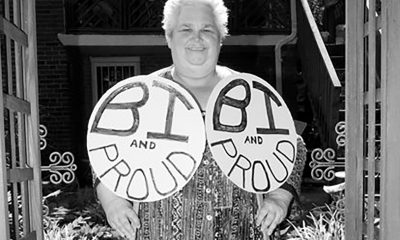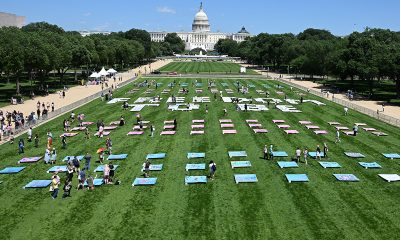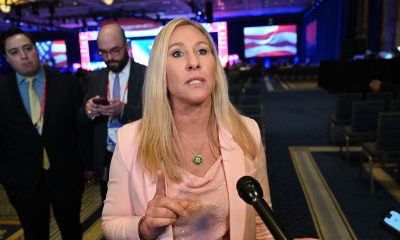Opinions
Carroll County’s flag policy: What counts as political?
Some statements are mandated while others are quashed
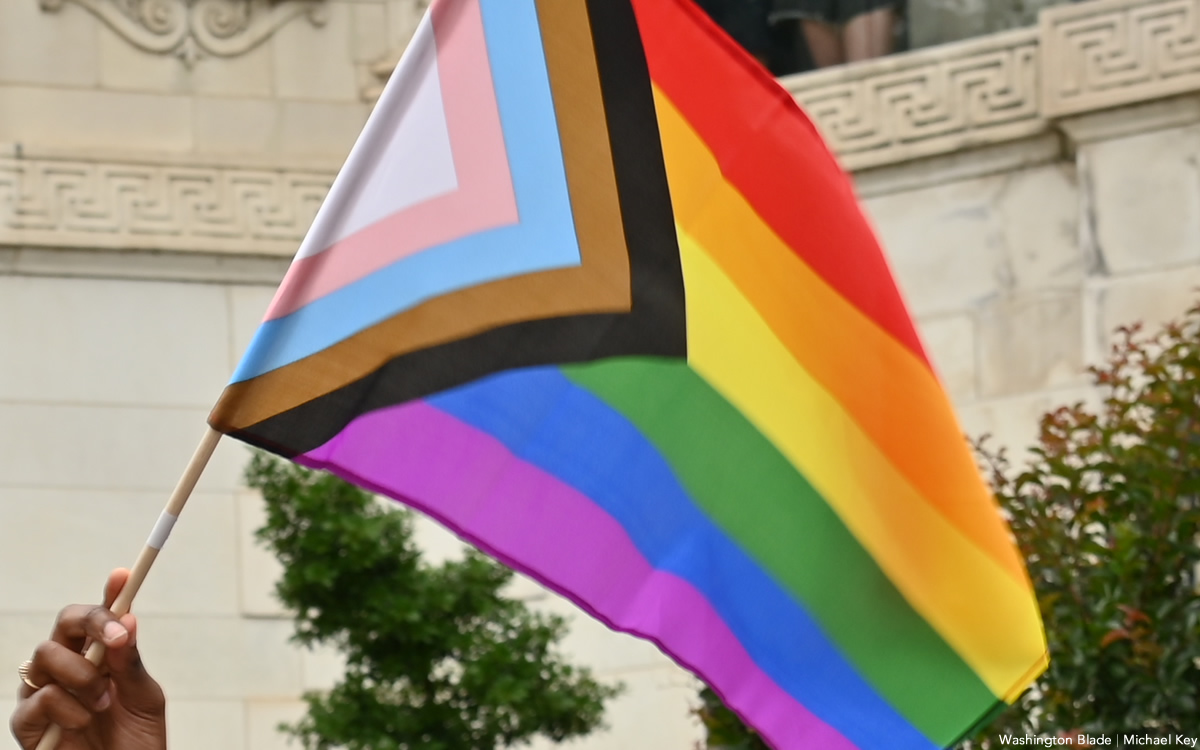
The Carroll County Board of Education earlier this month voted 4-1 to ban the display of most flags on public school grounds. The United States, Maryland, and Carroll County flags are still allowed, as are the flags of foreign nations and banners representing school achievements, school athletics, colleges, and professional sports teams. The main cause of controversy surrounding the policy is that it bans the display of Pride flags on public school grounds.
The concerns about how this policy will impact the inclusiveness of Carroll County Public Schools, and its students’ mental health, have been well-documented. The all-too-coincidental vote during Pride month has also been highlighted repeatedly. But I would like to point out some curious contradictions in the logic of the policy’s text itself. I question the sincerity of its objects. And to be clear, while I hope there are legal challenges to the policy on First Amendment grounds, I do not set out to refute the policy’s legality — I am not a lawyer.
Board member Donna Sivigny remarked how the flag policy was a “natural extension” of the school system’s political neutrality policy, which prohibits faculty and students from voicing their opinions on “political issues, parties, and candidates.” Along this line of neutrality, board member Tara Battaglia said, “And it’s true, where does it end? If we allow one [flag], we’re going to have to allow another, and we’re going to have to allow another.”
Edmund O’Meally, the board’s legal counsel, clarified that “We also have state law that requires the display of the official United States flag […] which requires the display of the flag in every classroom in every school in every school system in the state of Maryland.” He noted that the board’s flag policy is among the “time, place, and manner restrictions” that the board has the legal authority to impose on flags displayed on school grounds.
The flag policy begins, “The Board of Education of Carroll County agrees with Section 7-105(a) of the Education Article of the Annotated Code of Maryland that ‘the love of freedom and democracy, shown in the devotion of all true and patriotic Americans to their flag and country, shall be instilled in the hearts and minds’ of the students attending the Carroll County Public Schools.”
So it appears that state law does not require the display of the United States flag simply for aesthetic reasons. The code requires the display of the Stars and Stripes for political reasons. Simply put, democracy is a system of government, and love of democracy is a political viewpoint. To draw a distinction between anyone merely possessing American citizenship, and “true and patriotic” Americans, is a political statement. For better or worse, to instill this love of democracy is a political mission with which the State of Maryland tasks each school board. One must ask why certain political statements are not only permitted, but mandated by the state, and others are able to be quashed.
Beyond the national flag, whose display is required, scrutiny must be paid to the Maryland flag. Yes, its design is iconic and widely beloved by Marylanders. We reign supreme when it comes to how many items of clothing, bumper stickers, and other merchandise we brand with the state flag. However, its design is intentionally political. During the Civil War, Maryland was a border state; Union sympathizers would display the yellow and black Calvert arms, and Confederate partisans would display the red and white Crossland arms. A few decades after the Civil War ended, the Maryland flag as we know it today was adopted as a symbol of reconciliation and unity between North and South — certainly a political statement.
In addition, if international flags are allowed, attention must be paid to their symbolism as well. For instance, the designer of the flag of the People’s Republic of China described the largest yellow star on the banner as symbolizing the Chinese Communist Party. Even more broadly, the peoples of any colonized country generally view the flag of their colonizer as a political symbol.
So why would the Carroll County Board of Education welcome all these partisan discussions and displays, but prohibit symbols like the Pride flag? Yes, debates about LGBTQ rights are ongoing, but so are conversations about the Confederacy, communism, colonialism, and any number of other political organizations and viewpoints. It appears the board wants to limit what topics are worthy of consideration by erasing some from view.
We must work to resist all such hypocrisy and censorship when it arises.
Justin Drewer is a lifelong Maryland resident and a 2022 graduate of Georgetown University, where he majored in government, focusing on constitutional law.
Commentary
Elusive safety: what new global data reveals about gender, violence, and erasure
Movements against gender equality, lack of human rights data contributing factors.
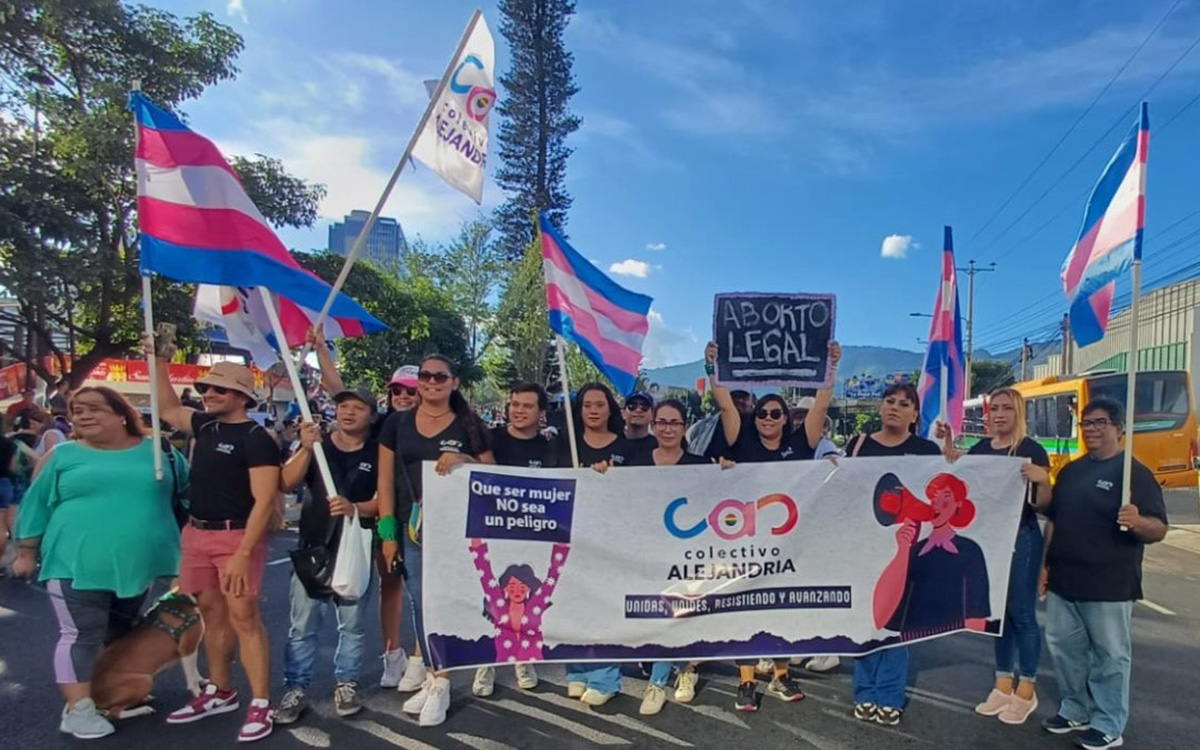
“My identity could be revealed, people can say whatever they want [online] without consequences. [Hormone replacement therapy] is illegal here so I’m just waiting to find a way to get out of here.”
-Anonymous respondent to the 2024 F&M Global Barometers LGBTQI+ Perception Index from Iraq, self-identified as a transgender woman and lesbian
As the campaign for 16 Days Against Gender-Based Violence begins, it is a reminder that gender-based violence (GBV) — both on– and offline — not only impacts women and girls but everyone who has been harmed or abused because of their gender or perceived gender. New research from the Franklin & Marshall (F&M) Global Barometers and its report A Growing Backlash: Quantifying the Experiences of LGBTQI+ People, 2022-2024 starkly show trends of declining safety among LGBTQI+ persons around the world.
This erosion of safety is accelerated by movements against gender equality and the disappearance of credible human rights data and reporting. The fight against GBV means understanding all people’s lived realities, including those of LGBTQI+ people, alongside the rights we continue to fight for.
We partnered together while at USAID and Franklin & Marshall College to expand the research and evidence base to better understand GBV against LGBTQI+ persons through the F&M Global Barometers. The collection of barometers tracks the legal rights and lived experiences of LGBTQI+ persons from 204 countries and territories from 2011 to the present. With more than a decade of data, it allows us to see how rights have progressed and receded as well as the gaps between legal protections and lived experiences of discrimination and violence.
This year’s data reveals alarming trends that highlight how fear and violence are, at its root, gendered phenomena that affect anyone who transgresses traditional gender norms.
<strong>LGBTQI+ people feel less safe</strong>
Nearly two-thirds of countries experienced a decline in their score on the F&M Global Barometers LGBTQI+ Perception Index (GBPI) from 2022-2024. This represents a five percent drop in global safety scores in just two years. With almost 70 percent of countries receiving an “F” grade on the GBPI, this suggests a global crisis in actual human rights protections for LGBTQI+ people.
Backsliding on LGBTQI+ human rights is happening everywhere, even in politically stable, established democracies with human rights protections for LGBTQI+ people. Countries in Western Europe and the Americas experienced the greatest negative GBPI score changes globally, 74 and 67 percent, respectively. Transgender people globally reported the highest likelihood of violence, while transwomen and intersex people reported the highest levels of feeling very unsafe or unsafe simply because of who they are.
<strong>Taboo of gender equality</strong>
Before this current administration dismantled USAID, I helped create an LGBTQI+ inclusive whole-of-government strategy to prevent and respond to GBV that highlighted the unique forms of GBV against LGBTQI+ persons. This included so-called ‘corrective’ rape related to actual or perceived sexual orientation, gender identity, or expression” and so-called ‘conversion’ therapy practices that seek to change or suppress a person’s gender identity or expression, sexual orientation, or sex characteristics. These efforts helped connect the dots in understanding that LGBTQI+ violence is rooted in the same systems of inequality and power imbalances as the broader spectrum of GBV against women and girls.
<strong>Losing data and accountability</strong>
Data that helps better understand GBV against LGBTQI+ persons is also disappearing. Again, the dismantling of USAID meant a treasure trove of research and reports on LGBTQI+ rights have been lost. Earlier this year, the US Department of State removed LGBTQI+ reporting from its annual Human Rights Reports. These played a critical role in providing credible sources for civil society, researchers, and policymakers to track abuses and advocate for change.
If violence isn’t documented, it’s easier for governments to deny it even exists and harder for us to hold governments accountable. Yet when systems of accountability work, governments and civil society can utilize data in international forums like the UN Universal Periodic Review, the Convention on the Elimination of All Forms of Discrimination Against Women, and the Sustainable Development Goals to assess progress and compliance and call for governments to improve protections.
All may not be lost if other countries and donors fill the void by supporting independent data collection and reporting efforts like the F&M Global Barometers and other academic and civil society monitoring. Such efforts are essential to the fight against GBV: The data helps show that the path toward safety, equality, and justice is within our reach if we’re unafraid of truth and visibility of those most marginalized and impacted.
Jay Gilliam (he/him/his) was the Senior LGBTQI+ Coordinator at USAID and is a member of the Global Outreach Advisory Council of the F&M Global Barometers.
Susan Dicklitch-Nelson (she/her/hers) is the founder of the F&M Global Barometers and Professor of Government at Franklin & Marshall College.
Commentary
Second ‘lavender scare’ is harming our veterans. We know how to fix it
Out in National Security has built Trans Veterans State and Local Policy Toolkit

Seventy years after the first “lavender scare” drove LGBTQ Americans from public service, a second version is taking shape. Executive directives and administrative reviews have targeted transgender servicemembers and veterans, producing a new wave of quiet separations and lost benefits.
The policy language is technical, but the result is personal. Veterans who served honorably now face disrupted healthcare, delayed credentials, or housing barriers that no act of Congress ever required. Once again, Americans who met every standard of service are being told that their identity disqualifies them from stability.
Out in National Security built the Trans Veterans State and Local Policy Toolkit to change that. The toolkit gives state and local governments a practical path to repair harm through three measurable actions.
First, continuity of care. States can keep veterans covered by adopting presumptive Medicaid eligibility, aligning timelines with VA enrollment, and training providers in evidence-based gender-affirming care following the World Professional Association for Transgender Health Standards of Care Version 8.
Second, employment, and licensing. Governors and boards can recognize Department of Defense credentials, expedite licensing under existing reciprocity compacts, and ensure nondiscrimination in state veterans’ employment statutes.
Third, housing stability. States can designate transgender-veteran housing liaisons, expand voucher access, and enforce fair-housing protections that already exist in law.
Each step can be taken administratively within 90 days and requires no new federal legislation. The goal is straightforward: small, state-level reforms that yield rapid, measurable improvement in veterans’ daily lives.
The toolkit was introduced during a Veterans Week event hosted by the Center for American Progress, where federal and state leaders joined Out in National Security to highlight the first wave of state agencies adopting its recommendations. The discussion underscored how targeted, administrative reforms can strengthen veterans’ healthcare, employment, and housing outcomes without new legislation. Full materials and implementation resources are now available at outinnationalsecurity.org/public-policy/toolkit, developed in partnership with Minority Veterans of America, the Modern Military Association of America, SPARTA Pride, and the Human Rights Campaign.
These are technical fixes, but they carry moral weight. They reaffirm a basic democratic promise: service earns respect, not suspicion.
As a policy professional who has worked with veterans across the country, I see this moment as a test of civic integrity. The measure of a democracy is not only who it allows to serve but how it treats them afterward.
The second “lavender scare” will end when institutions at every level decide that inclusion is an obligation, not an exception. The toolkit offers a way to begin.
For more information or to access the toolkit once it is public, visit outinnationalsecurity.org/toolkit.
Lucas F. Schleusener is the CEO of Out in National Security.

For years, the far right has relied on a familiar infrastructure to wage its political battles: coordinated legal networks, back-channeled money, and an ever-growing pipeline of model legislation that moves quietly from one statehouse to another. What used to be a fringe ecosystem of activist lawyers has matured into something far more muscular. Today, the attacks on LGBTQ Americans—especially transgender people—are not random. They are designed, drafted, and deployed by a disciplined constellation of groups that understand how to move legislation with precision. And if Democrats, civil rights advocates, and national LGBTQ organizations continue treating each bill as an isolated outrage rather than a unified offensive, this machine will keep outpacing them.
Most Americans have never heard of outfits like the Alliance Defending Freedom, the American Principles Project, the Leadership Institute’s law arm, or the network of state-based policy shops that orbit the Heritage Foundation. But these entities now function as the shadow authors of state legislation. The anti-trans sports bans that appeared in more than 20 states did not arise organically; they were cloned from drafts circulated by ADF attorneys. The same is true for bills restricting gender-affirming care, limiting name and pronoun accommodations in schools, or expanding “religious liberty” carve-outs that allow discrimination against LGBTQ employees or customers. Legislators often change a few words, swap in a local sponsor, and reintroduce the same provisions session after session — giving the impression of momentum when, in reality, only a handful of ideologues are writing the nation’s culture-war script.
The operational model is simple: produce a bill, partner with a state-level think tank, recruit a legislator to introduce it, and provide legal testimony to defend it. But the strategic sophistication lies upstream. These groups have spent years cultivating relationships with attorneys general, state solicitors, and conservative judges who are sympathetic to their worldview. They draft legislation with litigation in mind, anticipating which language will survive scrutiny before the federal courts they have worked diligently to remake. They treat policy, politics, and jurisprudence as a seamless ecosystem; meanwhile, LGBTQ advocates are forced to fight on three fronts at once, often with smaller budgets and no comparable network of state-by-state affiliates.
What is most striking now is the acceleration. Bills that used to be test-driven in one or two states are being introduced in a dozen simultaneously. After the Supreme Court’s Dobbs decision, the same legal strategists pushing abortion bans pivoted almost immediately toward restricting trans health care, framing puberty blockers and hormone therapy as “sterilization.” The rhetorical shift was not accidental. It was a deliberate legal construction designed to open the door to future Fourteenth Amendment challenges, should the movement secure a case capable of reaching the Supreme Court. This is not simply a legislative fight; it is the groundwork for long-term judicial warfare.
And yet, Democrats and even national LGBTQ groups often treat these measures as if they were spontaneous outbursts of local prejudice. That is politically naïve. The reason similar bills appear in Idaho, Florida, Tennessee, Kansas, and Ohio at the same time is because they originate from the same set of PDFs stored on the same servers belonging to the same legal networks. The far right has embraced an industrial model of anti-LGBTQ policymaking: mass production, rapid deployment, and coordinated amplification by media channels that echo the same talking points across state lines.
The consequence is that the burden falls on queer people themselves—especially trans people—to respond to an avalanche of bills, hearings, lawsuits, and administrative changes that no individual or small advocacy team can fully track. When you have a network of attorneys feeding language to legislators, drafting amicus briefs, and preparing future litigation strategies in advance, you create an asymmetry that is difficult to counter with reactive press releases or one-off legal challenges. This imbalance of power is not about public opinion, which still supports LGBTQ equality by wide margins. It is about institutional positioning. The far right has placed its lawyers where the pressure points are: in state AG offices, in coordinated legislative caucuses, in judicial clerkships, and in the nonprofit legal trenches where issue fights are shaped long before the public hears about them.
There is a path forward, but it requires abandoning the old model of treating each bill as a separate emergency. LGBTQ organizations need a unified, long-range strategy that mirrors the discipline of the groups attacking them. That means state-by-state legal surveillance, rapid drafting of counter-model legislation, formal partnerships with progressive state AGs, and a standing litigation coalition capable of anticipating—not just responding to—legal threats. It also means investing in local leaders who understand that these bills are symptoms of a national machine, not quirks of their hometown politics.
What’s at stake here is nothing less than the architecture of civil rights in the United States. The far right is attempting to rewrite the legal landscape through volume and repetition, hoping courts will eventually treat these contrived bills as reflections of a shifting national consensus. They are betting that if they introduce enough legislation, in enough states, for enough years, the judiciary will reinterpret LGBTQ equality not as a settled constitutional principle but as a contested social question that can be narrowed or rolled back. Their ultimate goal is not just to restrict trans rights today but to lay the doctrinal groundwork for limiting LGBTQ protections for a generation.
The community can still win this fight, but only if it sees the battlefield clearly. These bills are not local skirmishes—they are coordinated acts of legal engineering. And it is time the pro-equality movement built an equally coordinated system to match them.
Isaac Amend is a writer based in the D.C. area. He is a transgender man and was featured in National Geographic’s ‘Gender Revolution’ documentary. He serves on the board of the LGBT Democrats of Virginia. Contact him on Instagram at @isaacamend

